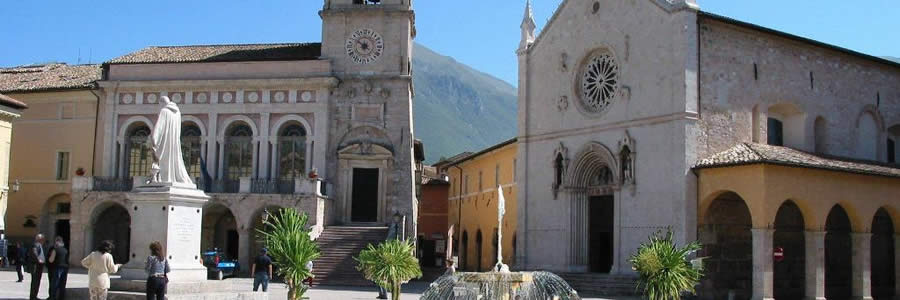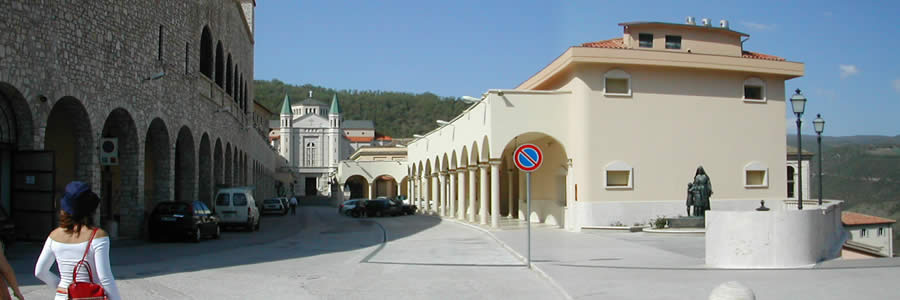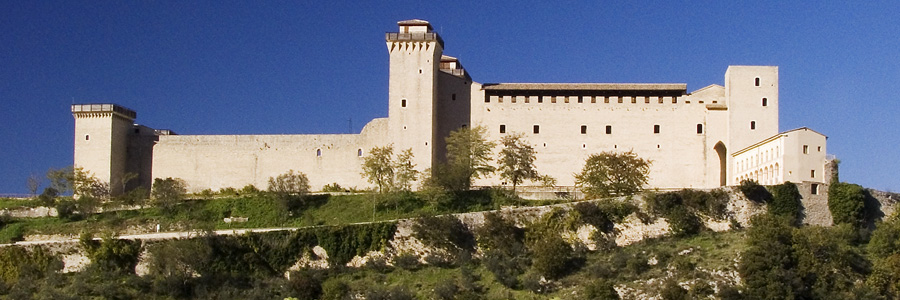Territorio
MONTELEONE has been founded by a noble Roman family, the Tibertis, in 1265: they were the owners of many and wide territories and they built up again the Castle of Brufa, felt down in 1100; they gave it, with other castle, to Spoleto.
Monteleone was an important bulwarg of Naples reign and of the Church reign.
It is surrounded by ancient walls and towers: its history can be divided in 6 different ages, till 1902, when a famous etruscan chariot was discovered in one of the etruscan tombs with many other old objects: it's made of wood and covered in embossed bronze leaf reproducting episodes from the life of Achilles.
Today the original chariot is in the Metropolitan Museum of New York, while you can admire a copy in Monteleone.
There are many ancient architectural complexes: 14 churches, San Francesco church, with the cloister and Renaissance convent, is the most important; 5 palaces (Bernabei, Congiunti...) and Tower of the Clock, in the old Market square.
Recently the Archeological department of Umbria has traced an area where, probably, other objects of the etruscan civilization can be discovered.
Cascia-Roccaporena it was an important Roman centre. As tourist attractions there are the civic museum and the church of Saint Antonio Abate with the famous “stories of Saint Antonio” painted by an Umbrian artist and “the scenes of the Passion of Christ” by Nicola da Siena.
Cascia and Roccaporena has become famous for Saint Rita, an Augustine nun born in 1381 in Roccaporena, who died in 1447. she was beatified by Pope Urbano VIII in 1628 and sanctified in 1900 by Pope Leo XIII.
In Roccaporena you can see the born house of the Saint, the garden where in the very cold winter of 1457 a beautiful rose blew and a fig ripenned.
Scheggino - it's a triangular-shaped, hillside castle-town, with a keep and watch-tower at the top. Scheggino was built on the left bank of the river Nera to guard the ancient road and one of the few crossing points across the river.
Its name probably derives from the structure of the terrain, featuring shards (scheggia) of rocks, where the town was built. There are medieval remains, include the walls, the watch-towers, doors and many bastions of the castle.
S. Pietro in Valle - it's an abbey built between the IV and VI century by the Duke of the Longobardi of Spoleto. It has been built in two different time the first it's longobardic (VII century) and the second Romanic (XII century). There are many medioeval and renaissance frescos, 5 romanic sarcophaguses and many others signs of a famous past of history and faith.
Ferentillo - it's a town in the wildest part of the Valnerina. In the XVI century the old chuch become the cementery of the town: in this way dead people started to mummify, discovered at the end of XX century. It's possible to visit the “cementery museum”.
Cascata delle Marmore - Marmore falls is not a natural fall, it's artificial, an important work of Romanic engineer; you can see the fall only in some hours in the day and not in all the days of the year. The water falls down for 165 m. in 3 different jumps. The water is used to produce energy.
Lago di Piediluco - it looks like an alpic lake, in the middle of the dark green of the mountains.
Spoleto - even it looks like a Romanic town, Spoleto has got an ancient aspect, medioeval thanks to the important period of the Longobardi, and then the period of the Reign of the Church. You must visit the “rocca albornoziana”: according to a popular tradition there are two underground ways who join the fortress to the centre of the town. The PONTE DELLE TORRI (“ the bridge of the towers”) is a very important monument of Spoleto: it's 82 meters high and it's the highest old bridge in Europe.
Assisi - on the beautiful land, where the rivers Topino and Chiascio flow, you can see the town of Assisi, where Saint Francesco and Saint Chiara were born. Very famous are the “Rocca Maggiore”, built again by the Cardinal Albornoz in 1367, the “Rocca Minore” and the churches of Saint Francesco, Saint Chiara and Saint Pietro. The duomo, dedicated to Saint Rufino, has already got a wonderful front with important sculptures.
Montefalco - the most important buildings you must visit are the palace of the borough of the 13th century, saint Agostino's Church, the Romanic church of Saint Bartolomeo and the church dedicated to Saint Chiara.
Between the typical products of this land the most important is a very tasty wine, “the Sagrantino”.
Norcia - it's situated between two different kind of landscapes: Valnerina, a long River Nera valley, with the sides of the mountain not very tall and rich in trees with perishable leaves; and Sibillini mountains, an area with very tall top, till 2000 m. above the sea level.
Norcia was a town of vital importance for the Sabines. Today the most impotant part of the town is the central square where you can see the oldest renaissance buildings.
Castelluccio di Norcia - it's a very beautiful mountain, where you can ski and at the same time you can have long walks on the big plains. In spring time all the plains are covered by many different kinds of flowers that make Castelluccio a big multicolour carpet.
Leonessa - it's one of Italy's smallest communes and the highest in the Valnerina. Its lonely position makes Poggiodomo a place of haven for monks and nuns, for wanted people during the centuries.
Poggiodomo - it's a mountain commune of Lazio that cofines to Monteleone.
It's very famous for its historical parade, that you can see on the 4th Sunday of june; the name is VELVET PARADE, because all the costumes are made of velvet. On the 3rd weekend of June all the horse riding lovers coming from all the italian regions come and make a parade. On the 2nd weekend of october there is the SAGRA DELLA PATATA: potatoe, french fries, “gnocchi” are cooked for many people who come to eat these typical dishes.




